Corporate Law: Analysis of a Case Study and Legal Concepts
VerifiedAdded on 2022/09/01
|9
|2331
|20
Report
AI Summary
This report analyzes a corporate law case study involving SRT Pty Ltd, examining potential breaches of director duties under the Corporations Act 2001. The analysis focuses on Mr. Sam and Mrs. Rosa's actions, including insolvent trading and failure to act in good faith, and assesses the legal consequences, including potential liability under sections 180, 181, 182, 183, and 588G. The report also evaluates the responsibilities of Mia and Charolette, the partners in the wholesale business, regarding the actions of Phillipa. The report concludes that the parties did not satisfy their lawful duties, breached their duties, and can be held liable. The report also references relevant case law and statutory provisions to support its conclusions, including ASIC v Australian Investors Forum Pty Ltd and the Bell Group Ltd v Westpac (No 9) case.
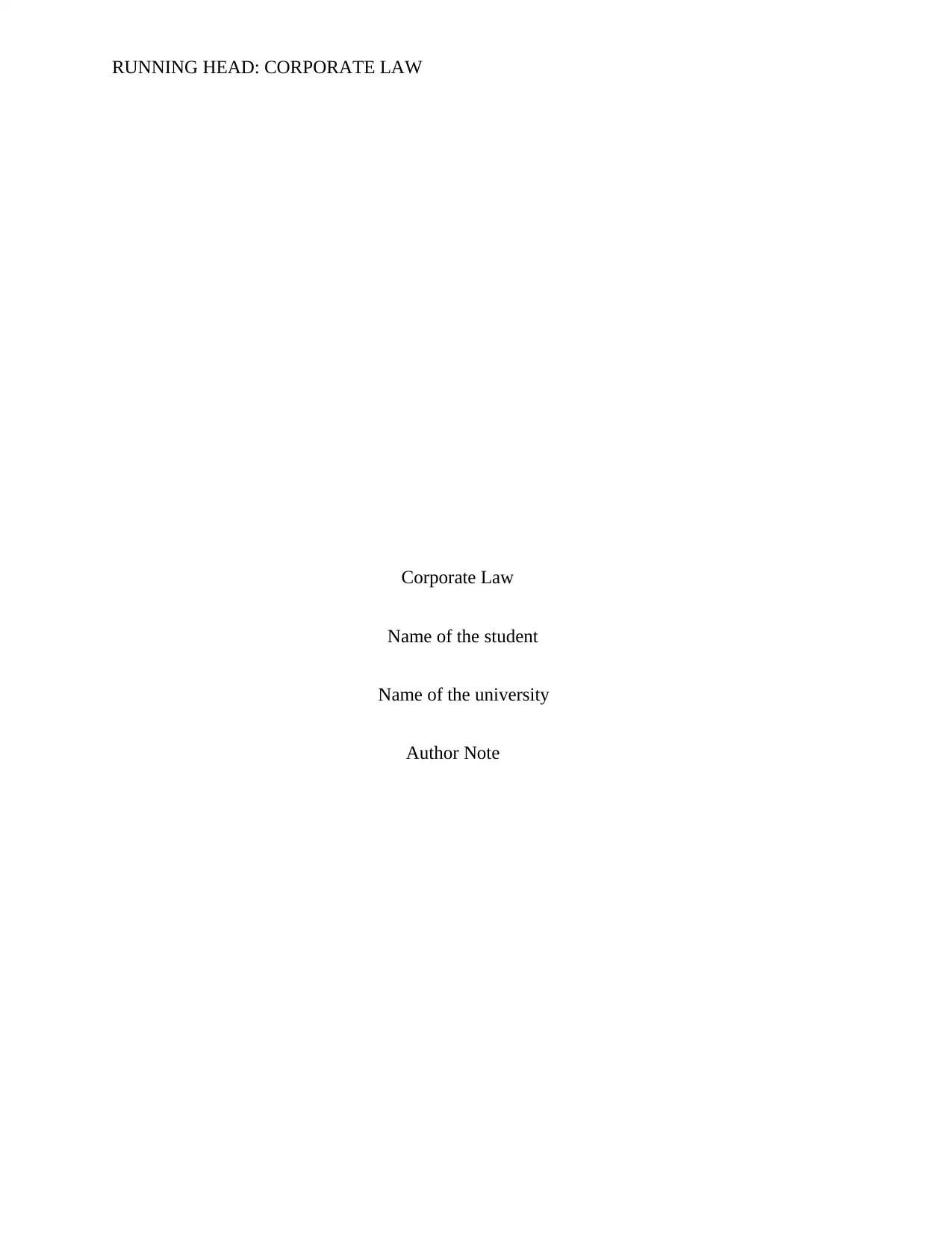
RUNNING HEAD: CORPORATE LAW
Corporate Law
Name of the student
Name of the university
Author Note
Corporate Law
Name of the student
Name of the university
Author Note
Paraphrase This Document
Need a fresh take? Get an instant paraphrase of this document with our AI Paraphraser
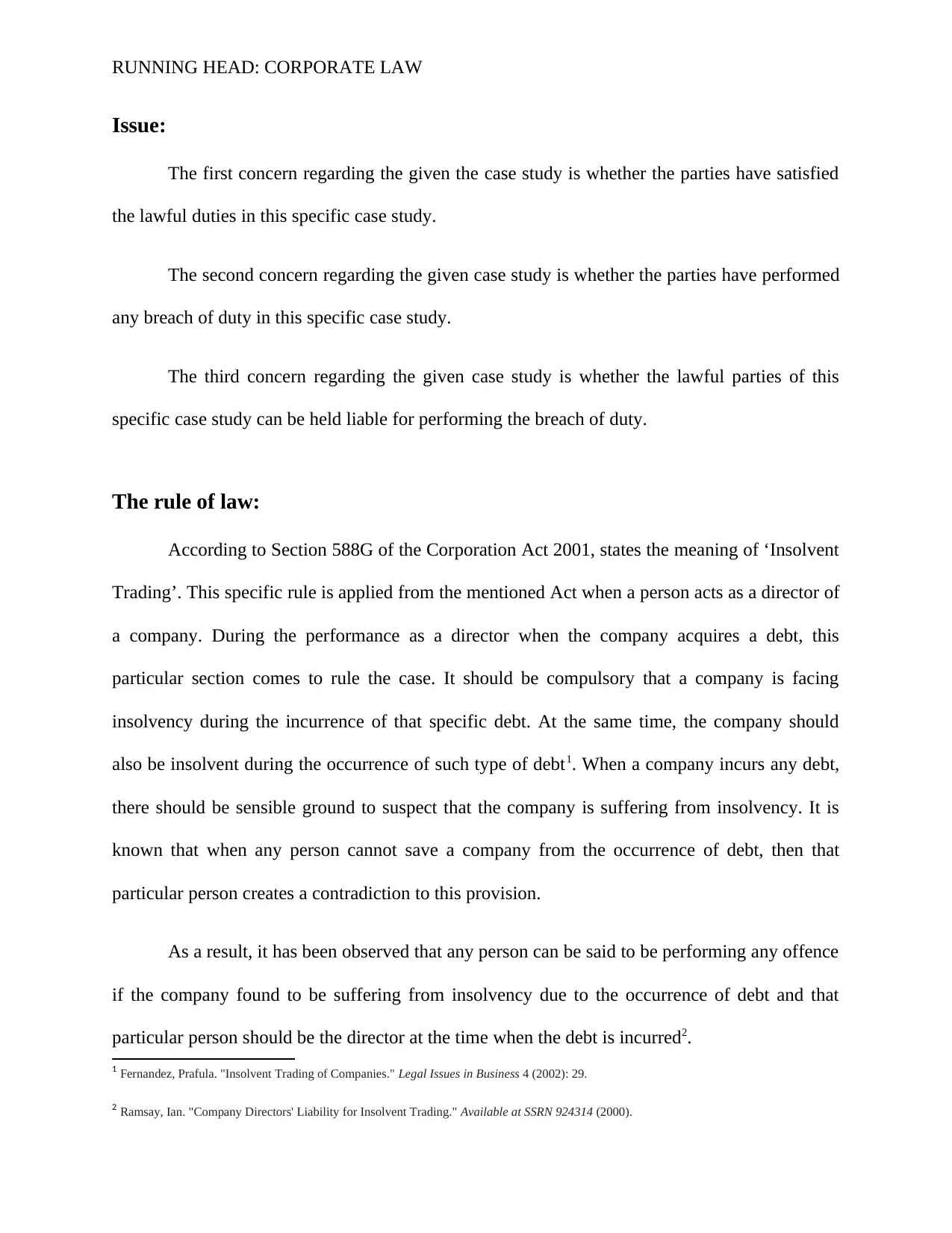
RUNNING HEAD: CORPORATE LAW
Issue:
The first concern regarding the given the case study is whether the parties have satisfied
the lawful duties in this specific case study.
The second concern regarding the given case study is whether the parties have performed
any breach of duty in this specific case study.
The third concern regarding the given case study is whether the lawful parties of this
specific case study can be held liable for performing the breach of duty.
The rule of law:
According to Section 588G of the Corporation Act 2001, states the meaning of ‘Insolvent
Trading’. This specific rule is applied from the mentioned Act when a person acts as a director of
a company. During the performance as a director when the company acquires a debt, this
particular section comes to rule the case. It should be compulsory that a company is facing
insolvency during the incurrence of that specific debt. At the same time, the company should
also be insolvent during the occurrence of such type of debt1. When a company incurs any debt,
there should be sensible ground to suspect that the company is suffering from insolvency. It is
known that when any person cannot save a company from the occurrence of debt, then that
particular person creates a contradiction to this provision.
As a result, it has been observed that any person can be said to be performing any offence
if the company found to be suffering from insolvency due to the occurrence of debt and that
particular person should be the director at the time when the debt is incurred2.
1 Fernandez, Prafula. "Insolvent Trading of Companies." Legal Issues in Business 4 (2002): 29.
2 Ramsay, Ian. "Company Directors' Liability for Insolvent Trading." Available at SSRN 924314 (2000).
Issue:
The first concern regarding the given the case study is whether the parties have satisfied
the lawful duties in this specific case study.
The second concern regarding the given case study is whether the parties have performed
any breach of duty in this specific case study.
The third concern regarding the given case study is whether the lawful parties of this
specific case study can be held liable for performing the breach of duty.
The rule of law:
According to Section 588G of the Corporation Act 2001, states the meaning of ‘Insolvent
Trading’. This specific rule is applied from the mentioned Act when a person acts as a director of
a company. During the performance as a director when the company acquires a debt, this
particular section comes to rule the case. It should be compulsory that a company is facing
insolvency during the incurrence of that specific debt. At the same time, the company should
also be insolvent during the occurrence of such type of debt1. When a company incurs any debt,
there should be sensible ground to suspect that the company is suffering from insolvency. It is
known that when any person cannot save a company from the occurrence of debt, then that
particular person creates a contradiction to this provision.
As a result, it has been observed that any person can be said to be performing any offence
if the company found to be suffering from insolvency due to the occurrence of debt and that
particular person should be the director at the time when the debt is incurred2.
1 Fernandez, Prafula. "Insolvent Trading of Companies." Legal Issues in Business 4 (2002): 29.
2 Ramsay, Ian. "Company Directors' Liability for Insolvent Trading." Available at SSRN 924314 (2000).
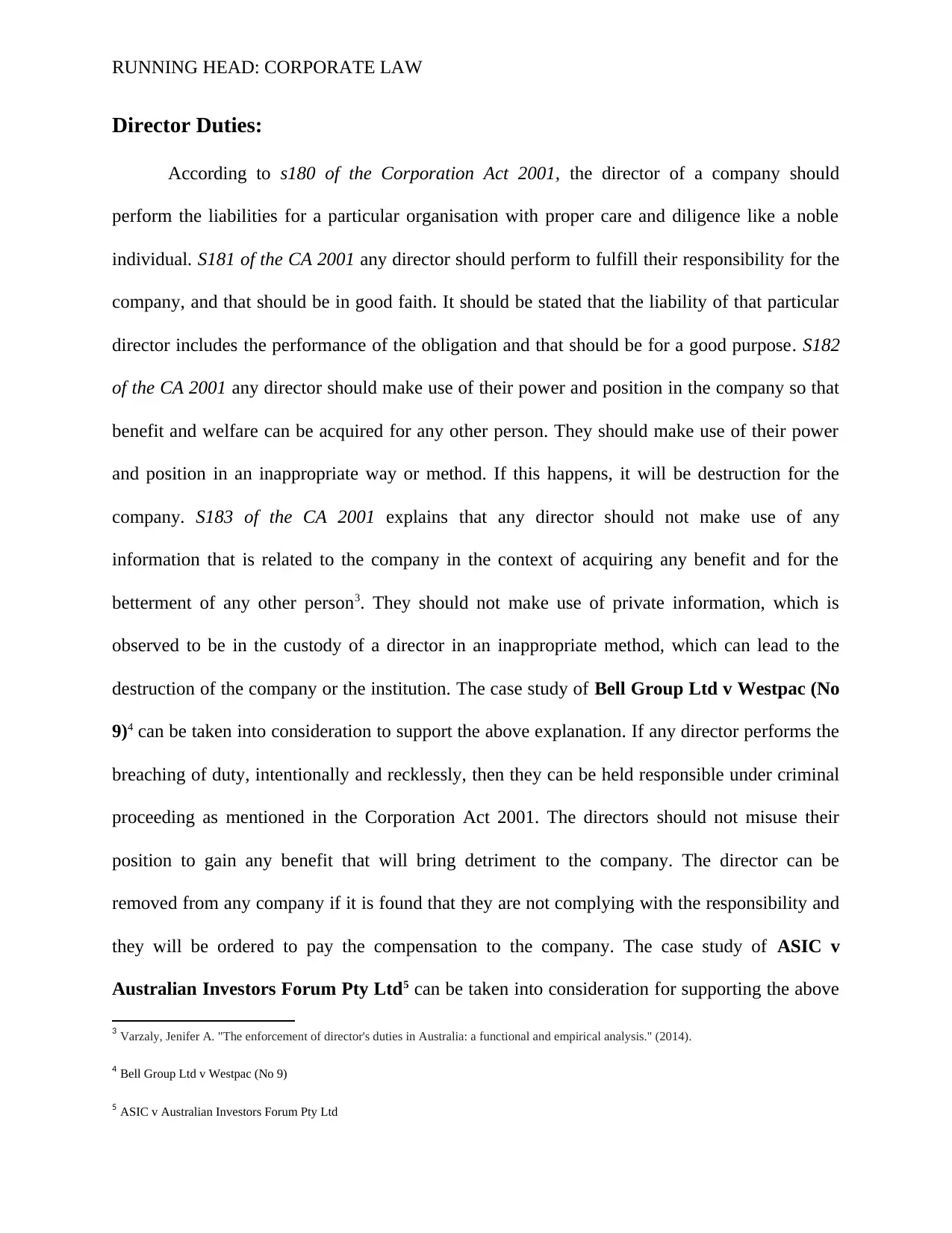
RUNNING HEAD: CORPORATE LAW
Director Duties:
According to s180 of the Corporation Act 2001, the director of a company should
perform the liabilities for a particular organisation with proper care and diligence like a noble
individual. S181 of the CA 2001 any director should perform to fulfill their responsibility for the
company, and that should be in good faith. It should be stated that the liability of that particular
director includes the performance of the obligation and that should be for a good purpose. S182
of the CA 2001 any director should make use of their power and position in the company so that
benefit and welfare can be acquired for any other person. They should make use of their power
and position in an inappropriate way or method. If this happens, it will be destruction for the
company. S183 of the CA 2001 explains that any director should not make use of any
information that is related to the company in the context of acquiring any benefit and for the
betterment of any other person3. They should not make use of private information, which is
observed to be in the custody of a director in an inappropriate method, which can lead to the
destruction of the company or the institution. The case study of Bell Group Ltd v Westpac (No
9)4 can be taken into consideration to support the above explanation. If any director performs the
breaching of duty, intentionally and recklessly, then they can be held responsible under criminal
proceeding as mentioned in the Corporation Act 2001. The directors should not misuse their
position to gain any benefit that will bring detriment to the company. The director can be
removed from any company if it is found that they are not complying with the responsibility and
they will be ordered to pay the compensation to the company. The case study of ASIC v
Australian Investors Forum Pty Ltd5 can be taken into consideration for supporting the above
3 Varzaly, Jenifer A. "The enforcement of director's duties in Australia: a functional and empirical analysis." (2014).
4 Bell Group Ltd v Westpac (No 9)
5 ASIC v Australian Investors Forum Pty Ltd
Director Duties:
According to s180 of the Corporation Act 2001, the director of a company should
perform the liabilities for a particular organisation with proper care and diligence like a noble
individual. S181 of the CA 2001 any director should perform to fulfill their responsibility for the
company, and that should be in good faith. It should be stated that the liability of that particular
director includes the performance of the obligation and that should be for a good purpose. S182
of the CA 2001 any director should make use of their power and position in the company so that
benefit and welfare can be acquired for any other person. They should make use of their power
and position in an inappropriate way or method. If this happens, it will be destruction for the
company. S183 of the CA 2001 explains that any director should not make use of any
information that is related to the company in the context of acquiring any benefit and for the
betterment of any other person3. They should not make use of private information, which is
observed to be in the custody of a director in an inappropriate method, which can lead to the
destruction of the company or the institution. The case study of Bell Group Ltd v Westpac (No
9)4 can be taken into consideration to support the above explanation. If any director performs the
breaching of duty, intentionally and recklessly, then they can be held responsible under criminal
proceeding as mentioned in the Corporation Act 2001. The directors should not misuse their
position to gain any benefit that will bring detriment to the company. The director can be
removed from any company if it is found that they are not complying with the responsibility and
they will be ordered to pay the compensation to the company. The case study of ASIC v
Australian Investors Forum Pty Ltd5 can be taken into consideration for supporting the above
3 Varzaly, Jenifer A. "The enforcement of director's duties in Australia: a functional and empirical analysis." (2014).
4 Bell Group Ltd v Westpac (No 9)
5 ASIC v Australian Investors Forum Pty Ltd
⊘ This is a preview!⊘
Do you want full access?
Subscribe today to unlock all pages.

Trusted by 1+ million students worldwide
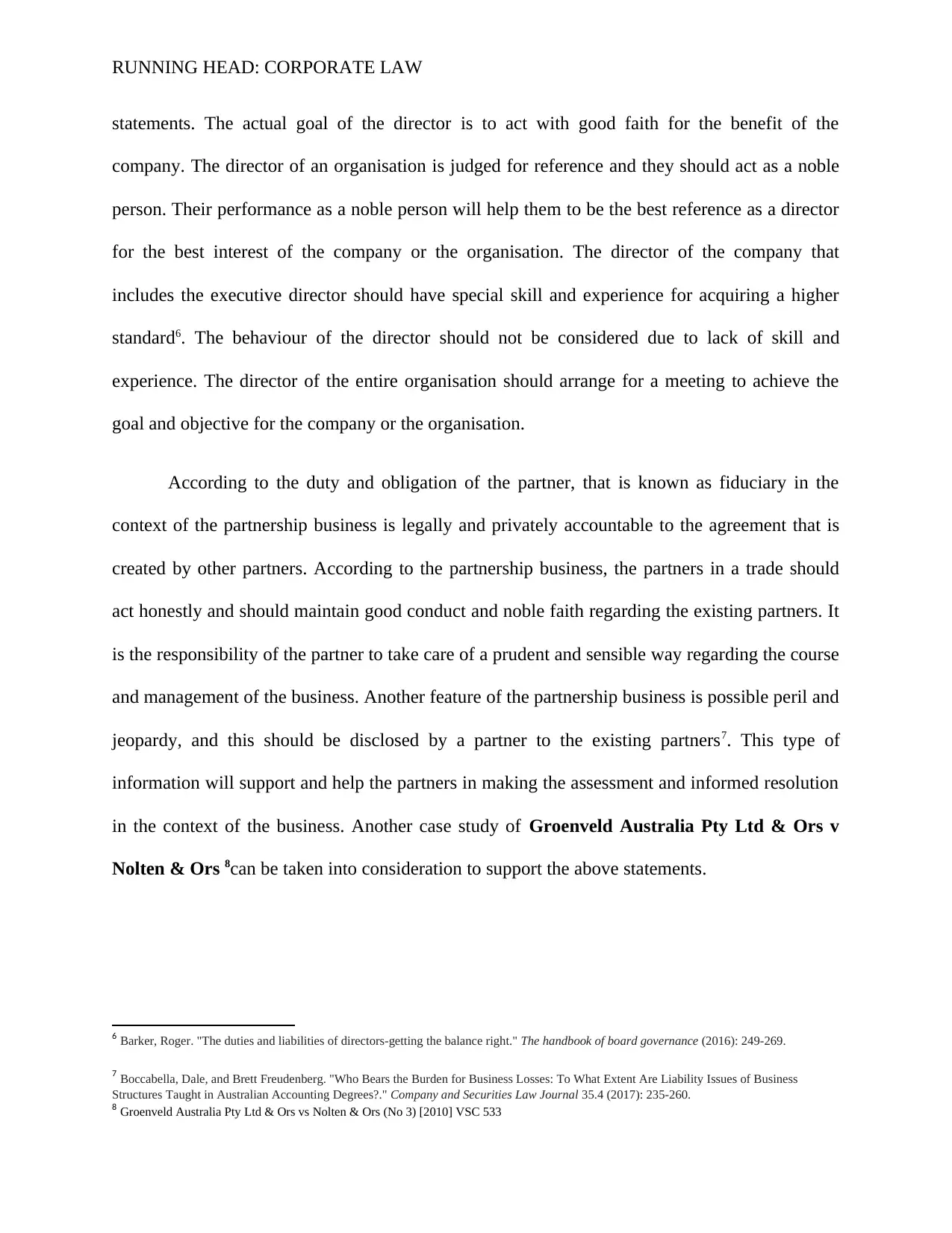
RUNNING HEAD: CORPORATE LAW
statements. The actual goal of the director is to act with good faith for the benefit of the
company. The director of an organisation is judged for reference and they should act as a noble
person. Their performance as a noble person will help them to be the best reference as a director
for the best interest of the company or the organisation. The director of the company that
includes the executive director should have special skill and experience for acquiring a higher
standard6. The behaviour of the director should not be considered due to lack of skill and
experience. The director of the entire organisation should arrange for a meeting to achieve the
goal and objective for the company or the organisation.
According to the duty and obligation of the partner, that is known as fiduciary in the
context of the partnership business is legally and privately accountable to the agreement that is
created by other partners. According to the partnership business, the partners in a trade should
act honestly and should maintain good conduct and noble faith regarding the existing partners. It
is the responsibility of the partner to take care of a prudent and sensible way regarding the course
and management of the business. Another feature of the partnership business is possible peril and
jeopardy, and this should be disclosed by a partner to the existing partners7. This type of
information will support and help the partners in making the assessment and informed resolution
in the context of the business. Another case study of Groenveld Australia Pty Ltd & Ors v
Nolten & Ors 8can be taken into consideration to support the above statements.
6 Barker, Roger. "The duties and liabilities of directors-getting the balance right." The handbook of board governance (2016): 249-269.
7 Boccabella, Dale, and Brett Freudenberg. "Who Bears the Burden for Business Losses: To What Extent Are Liability Issues of Business
Structures Taught in Australian Accounting Degrees?." Company and Securities Law Journal 35.4 (2017): 235-260.
8 Groenveld Australia Pty Ltd & Ors vs Nolten & Ors (No 3) [2010] VSC 533
statements. The actual goal of the director is to act with good faith for the benefit of the
company. The director of an organisation is judged for reference and they should act as a noble
person. Their performance as a noble person will help them to be the best reference as a director
for the best interest of the company or the organisation. The director of the company that
includes the executive director should have special skill and experience for acquiring a higher
standard6. The behaviour of the director should not be considered due to lack of skill and
experience. The director of the entire organisation should arrange for a meeting to achieve the
goal and objective for the company or the organisation.
According to the duty and obligation of the partner, that is known as fiduciary in the
context of the partnership business is legally and privately accountable to the agreement that is
created by other partners. According to the partnership business, the partners in a trade should
act honestly and should maintain good conduct and noble faith regarding the existing partners. It
is the responsibility of the partner to take care of a prudent and sensible way regarding the course
and management of the business. Another feature of the partnership business is possible peril and
jeopardy, and this should be disclosed by a partner to the existing partners7. This type of
information will support and help the partners in making the assessment and informed resolution
in the context of the business. Another case study of Groenveld Australia Pty Ltd & Ors v
Nolten & Ors 8can be taken into consideration to support the above statements.
6 Barker, Roger. "The duties and liabilities of directors-getting the balance right." The handbook of board governance (2016): 249-269.
7 Boccabella, Dale, and Brett Freudenberg. "Who Bears the Burden for Business Losses: To What Extent Are Liability Issues of Business
Structures Taught in Australian Accounting Degrees?." Company and Securities Law Journal 35.4 (2017): 235-260.
8 Groenveld Australia Pty Ltd & Ors vs Nolten & Ors (No 3) [2010] VSC 533
Paraphrase This Document
Need a fresh take? Get an instant paraphrase of this document with our AI Paraphraser
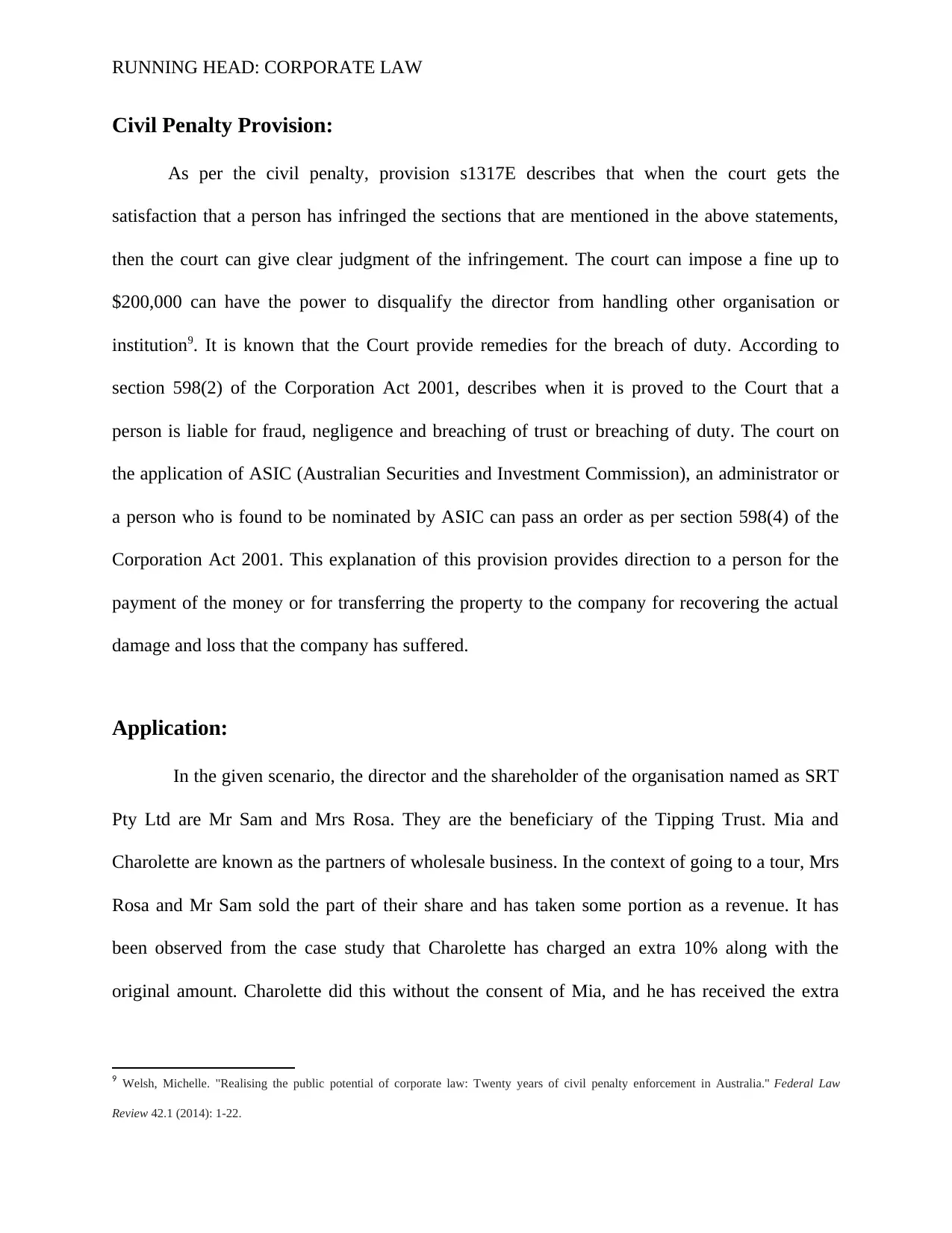
RUNNING HEAD: CORPORATE LAW
Civil Penalty Provision:
As per the civil penalty, provision s1317E describes that when the court gets the
satisfaction that a person has infringed the sections that are mentioned in the above statements,
then the court can give clear judgment of the infringement. The court can impose a fine up to
$200,000 can have the power to disqualify the director from handling other organisation or
institution9. It is known that the Court provide remedies for the breach of duty. According to
section 598(2) of the Corporation Act 2001, describes when it is proved to the Court that a
person is liable for fraud, negligence and breaching of trust or breaching of duty. The court on
the application of ASIC (Australian Securities and Investment Commission), an administrator or
a person who is found to be nominated by ASIC can pass an order as per section 598(4) of the
Corporation Act 2001. This explanation of this provision provides direction to a person for the
payment of the money or for transferring the property to the company for recovering the actual
damage and loss that the company has suffered.
Application:
In the given scenario, the director and the shareholder of the organisation named as SRT
Pty Ltd are Mr Sam and Mrs Rosa. They are the beneficiary of the Tipping Trust. Mia and
Charolette are known as the partners of wholesale business. In the context of going to a tour, Mrs
Rosa and Mr Sam sold the part of their share and has taken some portion as a revenue. It has
been observed from the case study that Charolette has charged an extra 10% along with the
original amount. Charolette did this without the consent of Mia, and he has received the extra
9 Welsh, Michelle. "Realising the public potential of corporate law: Twenty years of civil penalty enforcement in Australia." Federal Law
Review 42.1 (2014): 1-22.
Civil Penalty Provision:
As per the civil penalty, provision s1317E describes that when the court gets the
satisfaction that a person has infringed the sections that are mentioned in the above statements,
then the court can give clear judgment of the infringement. The court can impose a fine up to
$200,000 can have the power to disqualify the director from handling other organisation or
institution9. It is known that the Court provide remedies for the breach of duty. According to
section 598(2) of the Corporation Act 2001, describes when it is proved to the Court that a
person is liable for fraud, negligence and breaching of trust or breaching of duty. The court on
the application of ASIC (Australian Securities and Investment Commission), an administrator or
a person who is found to be nominated by ASIC can pass an order as per section 598(4) of the
Corporation Act 2001. This explanation of this provision provides direction to a person for the
payment of the money or for transferring the property to the company for recovering the actual
damage and loss that the company has suffered.
Application:
In the given scenario, the director and the shareholder of the organisation named as SRT
Pty Ltd are Mr Sam and Mrs Rosa. They are the beneficiary of the Tipping Trust. Mia and
Charolette are known as the partners of wholesale business. In the context of going to a tour, Mrs
Rosa and Mr Sam sold the part of their share and has taken some portion as a revenue. It has
been observed from the case study that Charolette has charged an extra 10% along with the
original amount. Charolette did this without the consent of Mia, and he has received the extra
9 Welsh, Michelle. "Realising the public potential of corporate law: Twenty years of civil penalty enforcement in Australia." Federal Law
Review 42.1 (2014): 1-22.
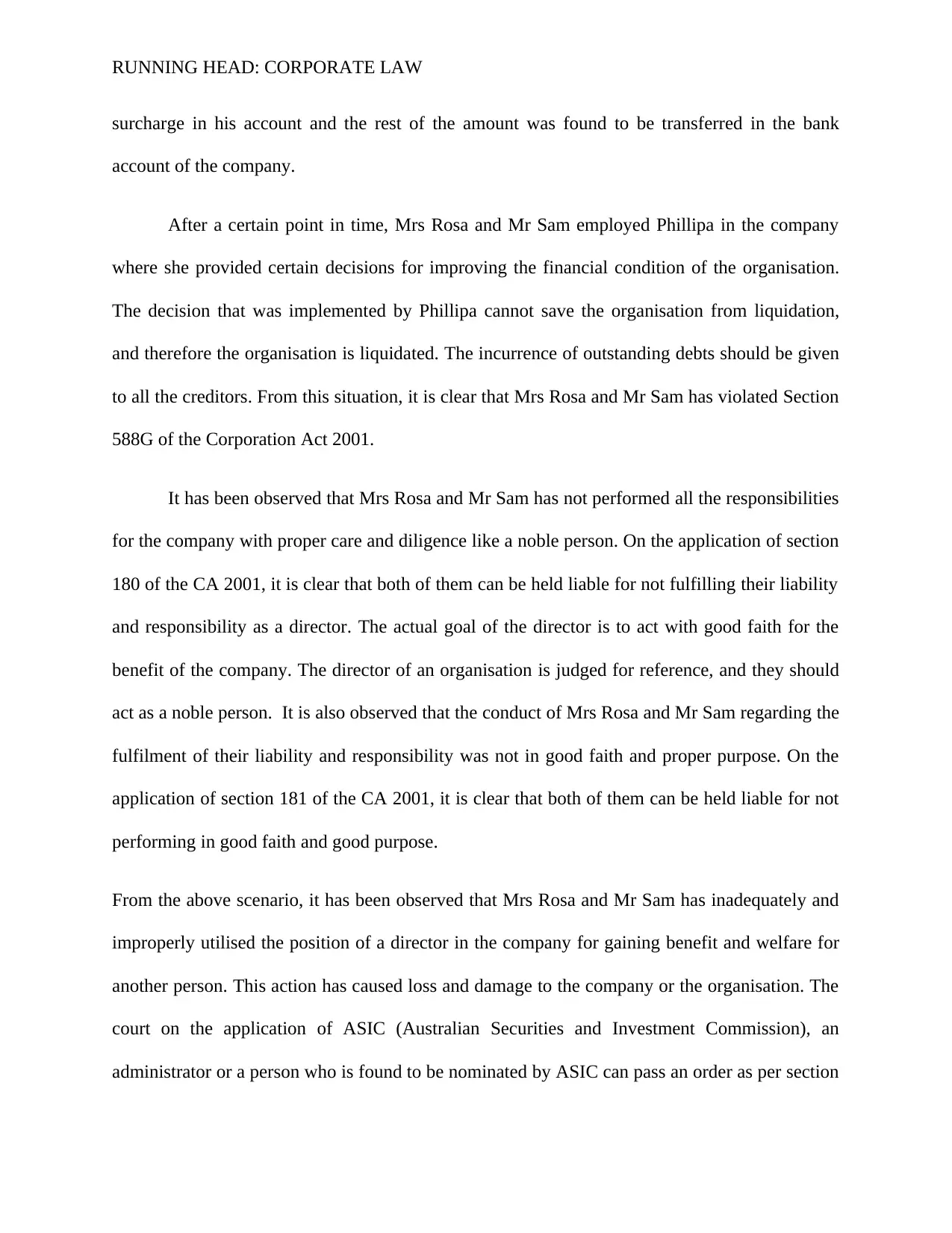
RUNNING HEAD: CORPORATE LAW
surcharge in his account and the rest of the amount was found to be transferred in the bank
account of the company.
After a certain point in time, Mrs Rosa and Mr Sam employed Phillipa in the company
where she provided certain decisions for improving the financial condition of the organisation.
The decision that was implemented by Phillipa cannot save the organisation from liquidation,
and therefore the organisation is liquidated. The incurrence of outstanding debts should be given
to all the creditors. From this situation, it is clear that Mrs Rosa and Mr Sam has violated Section
588G of the Corporation Act 2001.
It has been observed that Mrs Rosa and Mr Sam has not performed all the responsibilities
for the company with proper care and diligence like a noble person. On the application of section
180 of the CA 2001, it is clear that both of them can be held liable for not fulfilling their liability
and responsibility as a director. The actual goal of the director is to act with good faith for the
benefit of the company. The director of an organisation is judged for reference, and they should
act as a noble person. It is also observed that the conduct of Mrs Rosa and Mr Sam regarding the
fulfilment of their liability and responsibility was not in good faith and proper purpose. On the
application of section 181 of the CA 2001, it is clear that both of them can be held liable for not
performing in good faith and good purpose.
From the above scenario, it has been observed that Mrs Rosa and Mr Sam has inadequately and
improperly utilised the position of a director in the company for gaining benefit and welfare for
another person. This action has caused loss and damage to the company or the organisation. The
court on the application of ASIC (Australian Securities and Investment Commission), an
administrator or a person who is found to be nominated by ASIC can pass an order as per section
surcharge in his account and the rest of the amount was found to be transferred in the bank
account of the company.
After a certain point in time, Mrs Rosa and Mr Sam employed Phillipa in the company
where she provided certain decisions for improving the financial condition of the organisation.
The decision that was implemented by Phillipa cannot save the organisation from liquidation,
and therefore the organisation is liquidated. The incurrence of outstanding debts should be given
to all the creditors. From this situation, it is clear that Mrs Rosa and Mr Sam has violated Section
588G of the Corporation Act 2001.
It has been observed that Mrs Rosa and Mr Sam has not performed all the responsibilities
for the company with proper care and diligence like a noble person. On the application of section
180 of the CA 2001, it is clear that both of them can be held liable for not fulfilling their liability
and responsibility as a director. The actual goal of the director is to act with good faith for the
benefit of the company. The director of an organisation is judged for reference, and they should
act as a noble person. It is also observed that the conduct of Mrs Rosa and Mr Sam regarding the
fulfilment of their liability and responsibility was not in good faith and proper purpose. On the
application of section 181 of the CA 2001, it is clear that both of them can be held liable for not
performing in good faith and good purpose.
From the above scenario, it has been observed that Mrs Rosa and Mr Sam has inadequately and
improperly utilised the position of a director in the company for gaining benefit and welfare for
another person. This action has caused loss and damage to the company or the organisation. The
court on the application of ASIC (Australian Securities and Investment Commission), an
administrator or a person who is found to be nominated by ASIC can pass an order as per section
⊘ This is a preview!⊘
Do you want full access?
Subscribe today to unlock all pages.

Trusted by 1+ million students worldwide
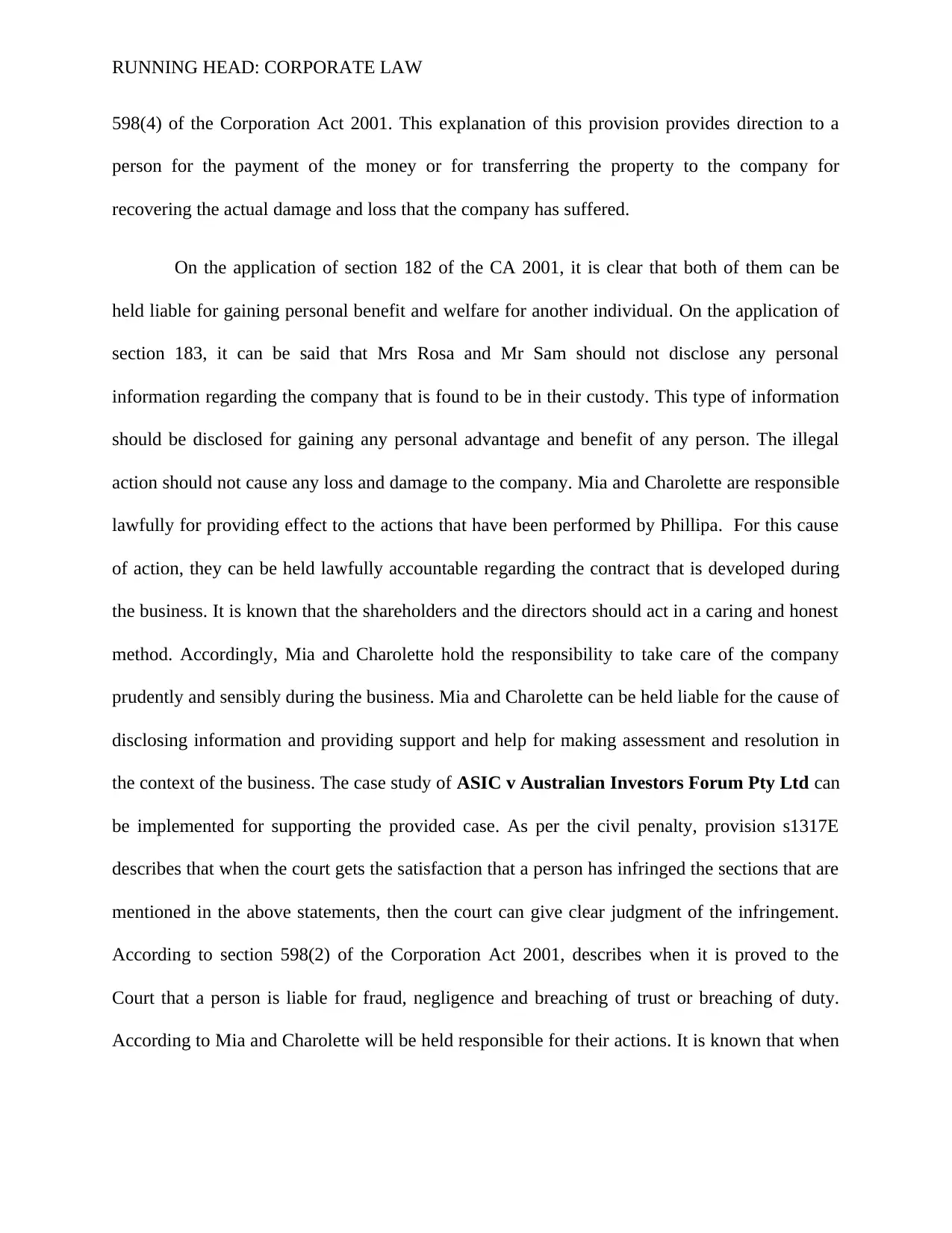
RUNNING HEAD: CORPORATE LAW
598(4) of the Corporation Act 2001. This explanation of this provision provides direction to a
person for the payment of the money or for transferring the property to the company for
recovering the actual damage and loss that the company has suffered.
On the application of section 182 of the CA 2001, it is clear that both of them can be
held liable for gaining personal benefit and welfare for another individual. On the application of
section 183, it can be said that Mrs Rosa and Mr Sam should not disclose any personal
information regarding the company that is found to be in their custody. This type of information
should be disclosed for gaining any personal advantage and benefit of any person. The illegal
action should not cause any loss and damage to the company. Mia and Charolette are responsible
lawfully for providing effect to the actions that have been performed by Phillipa. For this cause
of action, they can be held lawfully accountable regarding the contract that is developed during
the business. It is known that the shareholders and the directors should act in a caring and honest
method. Accordingly, Mia and Charolette hold the responsibility to take care of the company
prudently and sensibly during the business. Mia and Charolette can be held liable for the cause of
disclosing information and providing support and help for making assessment and resolution in
the context of the business. The case study of ASIC v Australian Investors Forum Pty Ltd can
be implemented for supporting the provided case. As per the civil penalty, provision s1317E
describes that when the court gets the satisfaction that a person has infringed the sections that are
mentioned in the above statements, then the court can give clear judgment of the infringement.
According to section 598(2) of the Corporation Act 2001, describes when it is proved to the
Court that a person is liable for fraud, negligence and breaching of trust or breaching of duty.
According to Mia and Charolette will be held responsible for their actions. It is known that when
598(4) of the Corporation Act 2001. This explanation of this provision provides direction to a
person for the payment of the money or for transferring the property to the company for
recovering the actual damage and loss that the company has suffered.
On the application of section 182 of the CA 2001, it is clear that both of them can be
held liable for gaining personal benefit and welfare for another individual. On the application of
section 183, it can be said that Mrs Rosa and Mr Sam should not disclose any personal
information regarding the company that is found to be in their custody. This type of information
should be disclosed for gaining any personal advantage and benefit of any person. The illegal
action should not cause any loss and damage to the company. Mia and Charolette are responsible
lawfully for providing effect to the actions that have been performed by Phillipa. For this cause
of action, they can be held lawfully accountable regarding the contract that is developed during
the business. It is known that the shareholders and the directors should act in a caring and honest
method. Accordingly, Mia and Charolette hold the responsibility to take care of the company
prudently and sensibly during the business. Mia and Charolette can be held liable for the cause of
disclosing information and providing support and help for making assessment and resolution in
the context of the business. The case study of ASIC v Australian Investors Forum Pty Ltd can
be implemented for supporting the provided case. As per the civil penalty, provision s1317E
describes that when the court gets the satisfaction that a person has infringed the sections that are
mentioned in the above statements, then the court can give clear judgment of the infringement.
According to section 598(2) of the Corporation Act 2001, describes when it is proved to the
Court that a person is liable for fraud, negligence and breaching of trust or breaching of duty.
According to Mia and Charolette will be held responsible for their actions. It is known that when
Paraphrase This Document
Need a fresh take? Get an instant paraphrase of this document with our AI Paraphraser
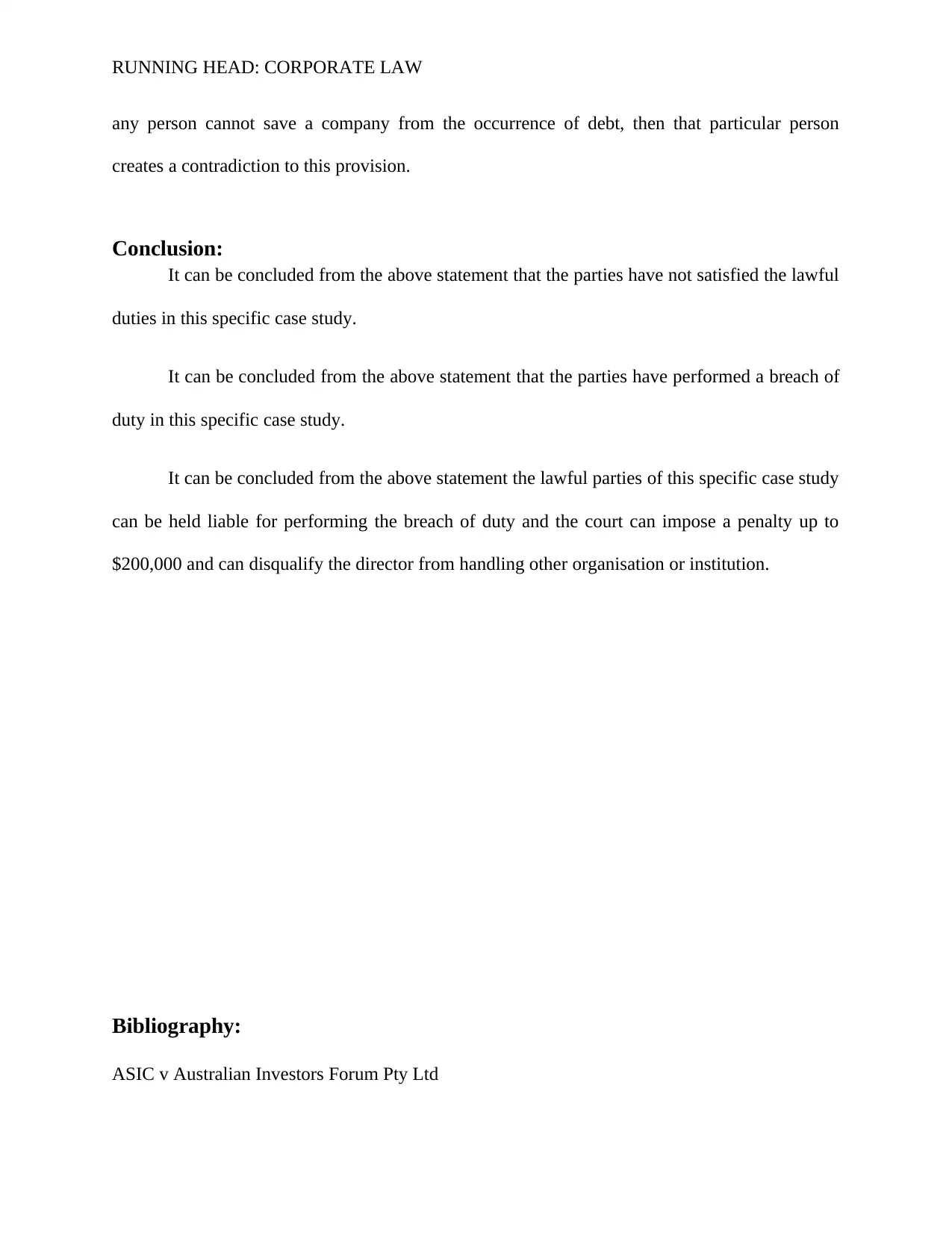
RUNNING HEAD: CORPORATE LAW
any person cannot save a company from the occurrence of debt, then that particular person
creates a contradiction to this provision.
Conclusion:
It can be concluded from the above statement that the parties have not satisfied the lawful
duties in this specific case study.
It can be concluded from the above statement that the parties have performed a breach of
duty in this specific case study.
It can be concluded from the above statement the lawful parties of this specific case study
can be held liable for performing the breach of duty and the court can impose a penalty up to
$200,000 and can disqualify the director from handling other organisation or institution.
Bibliography:
ASIC v Australian Investors Forum Pty Ltd
any person cannot save a company from the occurrence of debt, then that particular person
creates a contradiction to this provision.
Conclusion:
It can be concluded from the above statement that the parties have not satisfied the lawful
duties in this specific case study.
It can be concluded from the above statement that the parties have performed a breach of
duty in this specific case study.
It can be concluded from the above statement the lawful parties of this specific case study
can be held liable for performing the breach of duty and the court can impose a penalty up to
$200,000 and can disqualify the director from handling other organisation or institution.
Bibliography:
ASIC v Australian Investors Forum Pty Ltd
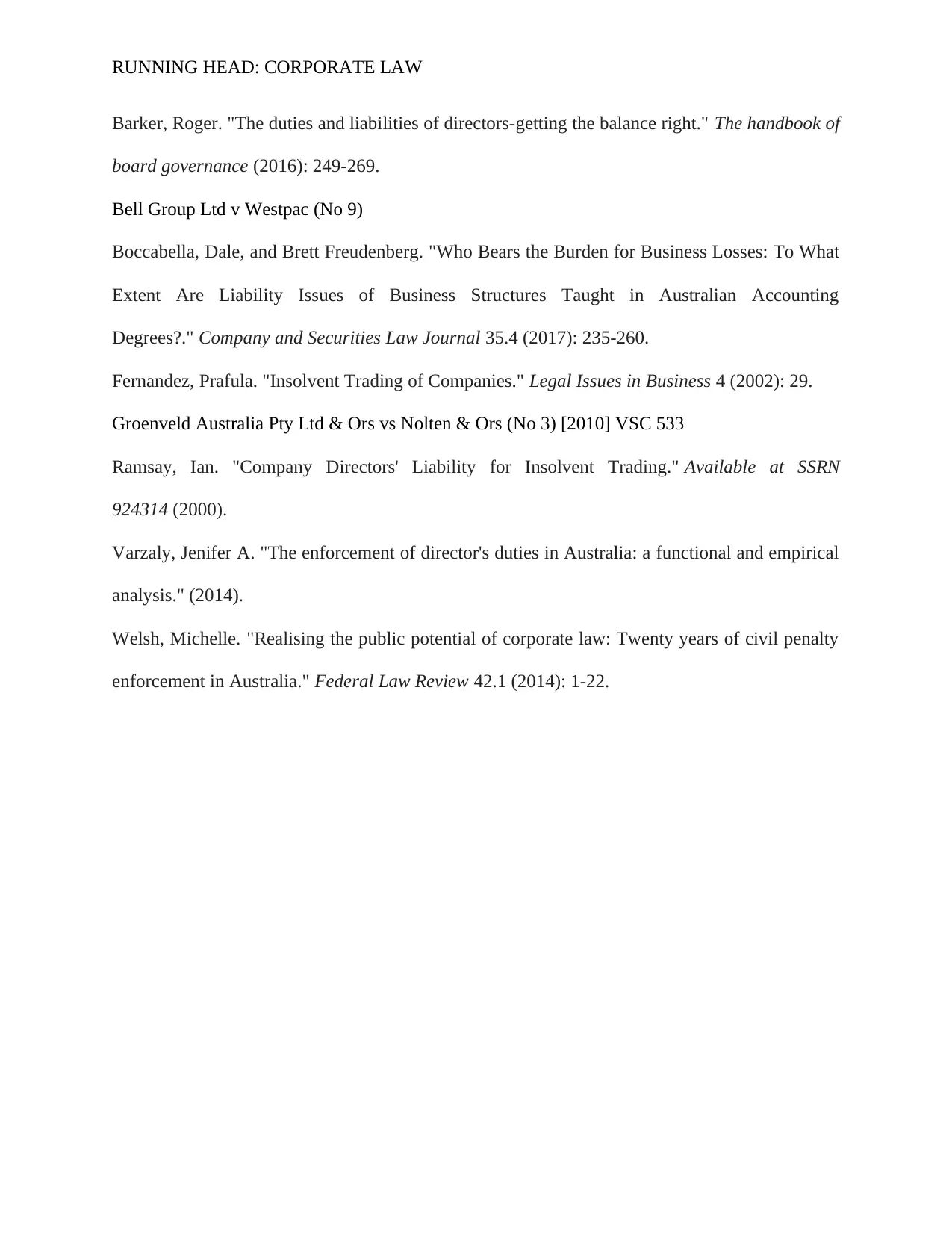
RUNNING HEAD: CORPORATE LAW
Barker, Roger. "The duties and liabilities of directors-getting the balance right." The handbook of
board governance (2016): 249-269.
Bell Group Ltd v Westpac (No 9)
Boccabella, Dale, and Brett Freudenberg. "Who Bears the Burden for Business Losses: To What
Extent Are Liability Issues of Business Structures Taught in Australian Accounting
Degrees?." Company and Securities Law Journal 35.4 (2017): 235-260.
Fernandez, Prafula. "Insolvent Trading of Companies." Legal Issues in Business 4 (2002): 29.
Groenveld Australia Pty Ltd & Ors vs Nolten & Ors (No 3) [2010] VSC 533
Ramsay, Ian. "Company Directors' Liability for Insolvent Trading." Available at SSRN
924314 (2000).
Varzaly, Jenifer A. "The enforcement of director's duties in Australia: a functional and empirical
analysis." (2014).
Welsh, Michelle. "Realising the public potential of corporate law: Twenty years of civil penalty
enforcement in Australia." Federal Law Review 42.1 (2014): 1-22.
Barker, Roger. "The duties and liabilities of directors-getting the balance right." The handbook of
board governance (2016): 249-269.
Bell Group Ltd v Westpac (No 9)
Boccabella, Dale, and Brett Freudenberg. "Who Bears the Burden for Business Losses: To What
Extent Are Liability Issues of Business Structures Taught in Australian Accounting
Degrees?." Company and Securities Law Journal 35.4 (2017): 235-260.
Fernandez, Prafula. "Insolvent Trading of Companies." Legal Issues in Business 4 (2002): 29.
Groenveld Australia Pty Ltd & Ors vs Nolten & Ors (No 3) [2010] VSC 533
Ramsay, Ian. "Company Directors' Liability for Insolvent Trading." Available at SSRN
924314 (2000).
Varzaly, Jenifer A. "The enforcement of director's duties in Australia: a functional and empirical
analysis." (2014).
Welsh, Michelle. "Realising the public potential of corporate law: Twenty years of civil penalty
enforcement in Australia." Federal Law Review 42.1 (2014): 1-22.
⊘ This is a preview!⊘
Do you want full access?
Subscribe today to unlock all pages.

Trusted by 1+ million students worldwide
1 out of 9
Related Documents
Your All-in-One AI-Powered Toolkit for Academic Success.
+13062052269
info@desklib.com
Available 24*7 on WhatsApp / Email
![[object Object]](/_next/static/media/star-bottom.7253800d.svg)
Unlock your academic potential
Copyright © 2020–2025 A2Z Services. All Rights Reserved. Developed and managed by ZUCOL.





